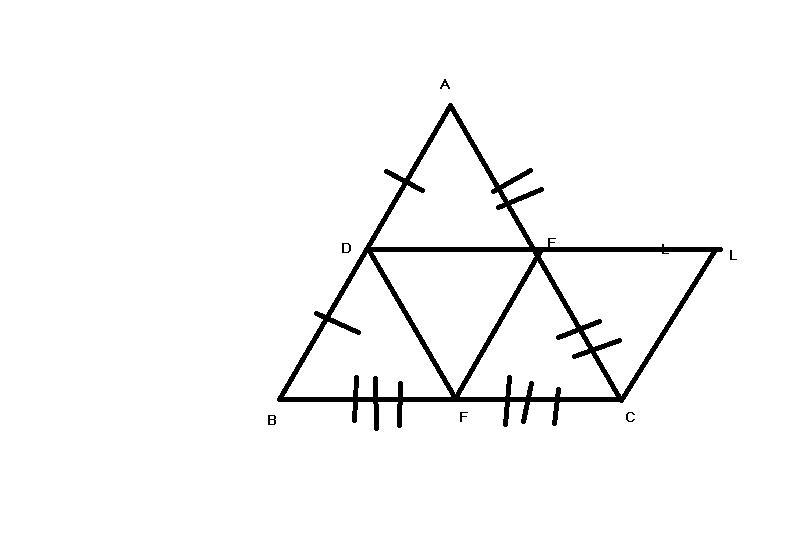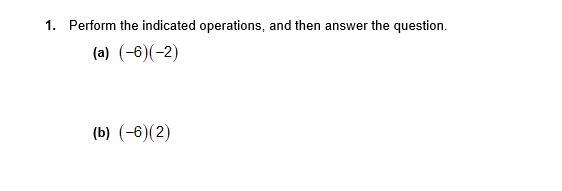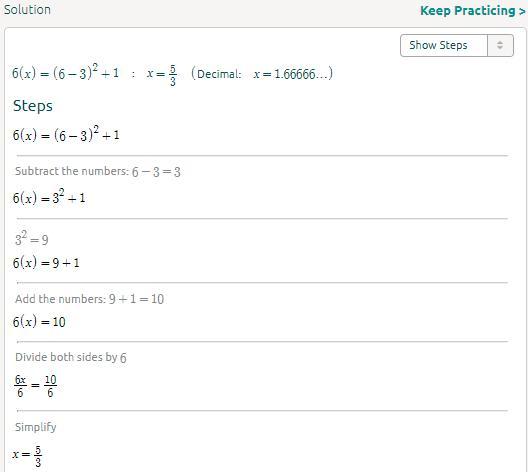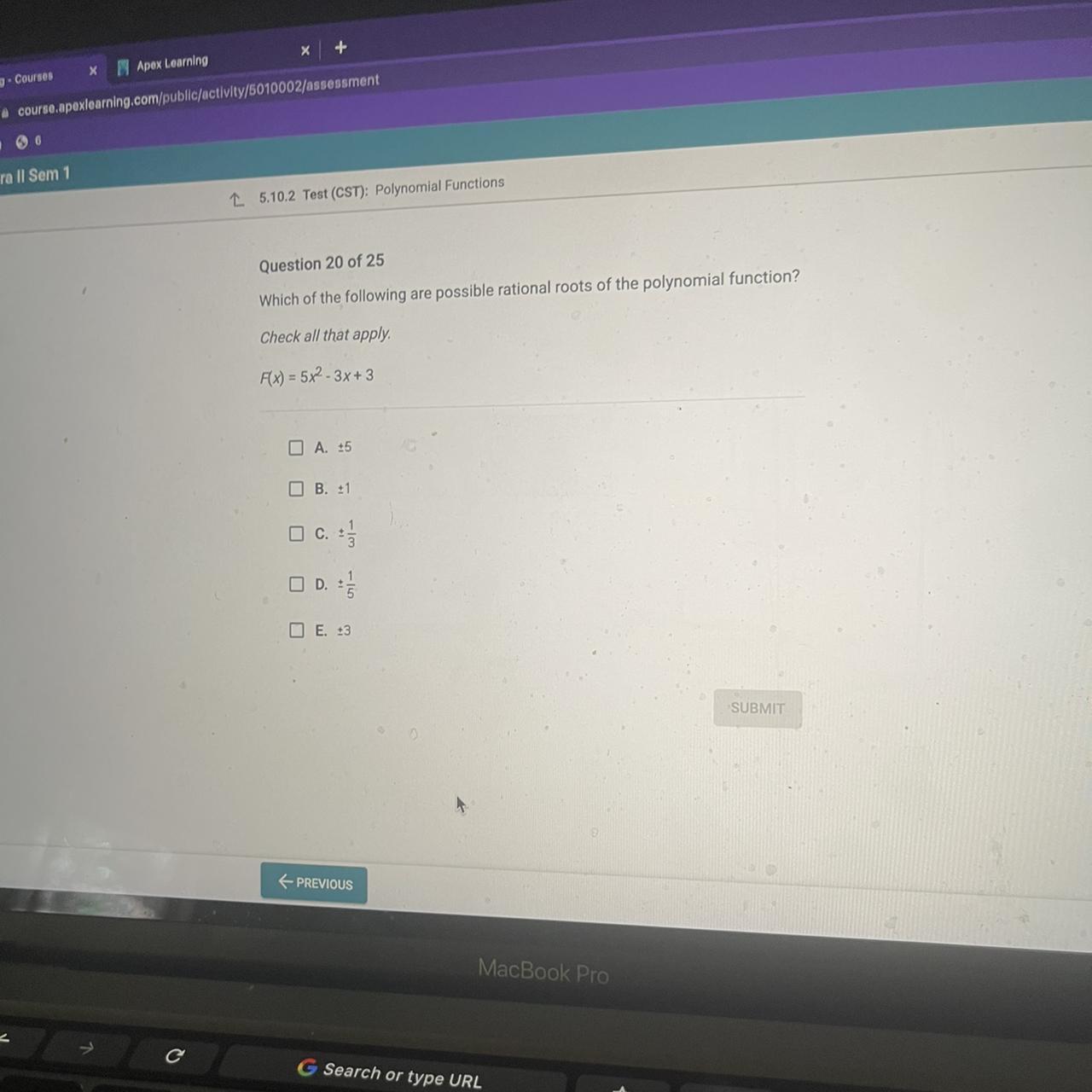Answers
This question has two steps, one is trigonometry, which should get us an equation to work with.
The second is algebra where we will have to use the equation we got to find x.
Assuming R is the center of the circle, we can see that the central angle ∠SRU is not equal to a value, but an expression:
\(\angle SRU=2x-32\degree\)And the inscribed angle ∠STU has the value 70°:
\(\angle STU=70\degree\)The value of an inscribed angle is the same as half the its central angle. This means that the value of ∠STU should be equal to half the value of ∠SRU:
\(\angle STU=\frac{\angle SRU}{2}\)Now, we can input the values we have for these angles:
\(70\degree=\frac{2x-32\degree}{2}\)Now, the trigonometric part ended, and we just have to solve the equation for x:
\(\begin{gathered} 70\degree=\frac{2x-32\degree}{2} \\ \frac{2x-32\degree}{2}=70\degree \\ 2x-32\degree=2\cdot70\degree \\ 2x-32\degree=140\degree \\ 2x=140\degree+32\degree \\ 2x=172\degree \\ x=\frac{172\degree}{2} \\ x=86\degree \end{gathered}\)So, the value of x is 86°.
Related Questions
PLEASE HELP ME
If f(x) = -3 and g(x) = 4x2 + x = 4, find (f+ g)(x).
ОА
A. 4x2 + x - 1
O B. 6x2 - 7
O 4x
C. 43+ + 2x-1
O D. 4x+3x-7

Answers
Answer:
D. 4x² + 3x/2 - 7
General Formulas and Concepts:
Pre-Algebra
Order of Operations: BPEMDAS
Brackets Parenthesis Exponents Multiplication Division Addition Subtraction Left to RightAlgebra I
Terms/CoefficientsFunctionsFunction NotationStep-by-step explanation:
Step 1: Define
Identify
f(x) = x/2 - 3
g(x) = 4x² + x - 4
(f + g)(x) is f(x) + g(x)
Step 2: Find
Substitute in functions: (f + g)(x) = x/2 - 3 + 4x² + x - 4Combine like terms: (f + g)(x) = 4x² + 3x/2 - 7Answer:
The answer is C.
Step-by-step explanation:
(f+g)(x)= f(x)+g(x).
So that would be x/2-3 + 4x^2+x-4.
If you combine like terms that would be:
4x^2+x/2+x-4-3=
4x^2+3/2x-7
The half-life of Carbon is 5730 years. If 10 grams of Carbon are present at time t = 0, how many will be present in 2,000 years?
Answers
The amount of Carbon that will be presented in 2,000 years is given as follows:
7.85 grams.
What is an exponential function?An exponential function is defined as follows:
y = a(b)^(x/n).
In which:
a is the initial amount.b is the rate of change.n is the time needed for the rate of change.Considering the initial amount of 10 grams and the half life of 5730 years, the parameters for this problem are given as follows:
a = 10, b = 0.5, n = 5730.
Hence the function is defined as follows:
y = 10(0.5)^(x/5730)
Then the amount after 2,000 years is given as follows:
y = 10(0.5)^(2000/5730)
y = 7.85 grams.
More can be learned about exponential functions at https://brainly.com/question/30113628
#SPJ1
three baskets weigh 120 pounds how many pounds are 4 baskets
Answers
Answer:
160
Step-by-step explanation:
\(\frac{120}{3} = 40\\40*4 = 160\)
A line segment (DE) joining the midpoints of two sides of a triangle is
parallel
to the third sid
Answers
Answer:
This is called a mid segment theorem in which the al ine segment (DE) joining the midpoints of two sides of a triangle is parallel to the third side.
Step-by-step explanation:
Suppose we have a triangle ABC. Then the midpoints can be located as D, E and F. If we join D , E and F another triangle is formed.
From the figure we can see that
AE≅ CE
AD≅DB
BF≅CF
BECAUSE all the given points are the midpoints which divide the lines into two equal halves.
If we increase the line DE to a point L we find out that DL is parallel to BC i.e. it does not meet at any point with BC. ( the two lines do not meet)
(1)
If we join C with L we find out that the the line DE is half in length to the line BC.
AS
AE= CE (midpoints dividing into equal line segements.)
LE= DE
Triangle CEL= Triangle DEF
so
DL= BC
But DE = 1/2 DL
therefore
DE= 1/2 BC (2)
Therefore from 1 and 2 we find that a line segment (DE) joining the midpoints of two sides of a triangle is parallel to the third side

A red purse contains $7, and a black purse contains $10. Each package contains X red purses and Y black purses. If there are N packages (N ≥ 2) and the total value of them is $2021 and if each of X, Y, and N are positive integers, what is X+Y+N?
Answers
If each of X, Y, and N are positive integers, then the value of X+Y+N is 212.1
What are system of inequalities?A collection of inequalities for which we consider common solution for all inequalities is called a system of inequalities.
WE are given that A red purse contains $7, and a black purse contains $10. Each package contains X red purses and Y black purses.
X = 7
Y = 10
If there are N packages (N ≥ 2) and the total value of them is $2021
X + Y = One packages
N packages = N(X + Y ) = 10 N
if each of X, Y, and N are positive integers, then;
10 N = 2021
N = 2021/10
N = 202.1
Therefore, X+Y+N = 10 + 202.1 = 212.1
Learn more about solutions to the system of inequalities here:
https://brainly.com/question/16339562
#SPJ1
Can you give me the answer thx

Answers
Step-by-step explanation:
you shuld us student demos brow it wold grafe that for you easyly
283838383838382828 + 8383838388828299383838383838288888 =
A
B
C
D
Answers
Answer:
8.3838384e+33
Step-by-step explanation:
283838383838382828 + 8383838388828299383838383838288888 = 8.3838384e+33
A person draws a card from a hat. Each card is one color, with the following probabilities of being drawn: 1/10 for pink, 1/15 for white, 1/20 for blue, and 1/5 for black. What is the probability of pulling a black or pink card, written as a reduced fraction?
Answers
Answer:
wouldn't it be 1/25 black??
√24 + √27 in the form of k√3
Answers
\(\sqrt{24}+\sqrt{27} ~~ \begin{cases} 24=2\cdot 2\cdot 2\cdot 3\\ \qquad 2^2\cdot 2\cdot 3\\ 27=3\cdot 3\cdot 3\\ \qquad 3^2\cdot 3 \end{cases}\implies \sqrt{2^2\cdot 2\cdot 3}+\sqrt{3^2\cdot 3} \\\\\\ 2\sqrt{2\cdot 3}+3\sqrt{3}\implies 2\sqrt{2}\cdot \sqrt{3}+3\sqrt{3}\implies \stackrel{\textit{common factoring}}{\underset{ \textit{\LARGE k} }{(2\sqrt{2}+3)} ~~ \sqrt{3}}\)
A function and its inverse are shown on the same graph.
f(x)
x
6.
Which statement describes the relationship between the
function and its inverse?
O The slope of f¹(x) is the same as the slope of f(x).
The slope of f¹(x) is the opposite as the slope of f(x).
O The x-intercept of f¹(x) is the same as the y-intercep
of f(x).
The x-intercept of f¹(x) is the opposite as the y-
intercept of f(x).
Answers
Answer:
(c) The x-intercept of f⁻¹(x) is the same as the y-intercept of f(x).
Step-by-step explanation:
You want to know the relationship between the graphs of function f(x) and its inverse f⁻¹(x).
Inverse functionThe inverse of a function maps every y-value of the original function to its corresponding x-value. That is if you have ...
f(a) = b
then the graph of f(x) contains the ordered pair (a, b).
The inverse function will have the ordered pair (b, a). That is,
f⁻¹(b) = a
ApplicationIf an ordered pair (x-intercept) of the inverse function is ...
(P, 0)
Then there will be an ordered pair (0, P) on the graph of the original function. That point is the y-intercept, and its y-coordinate is the same as the x-coordinate of the x-intercept of the inverse function.
The x-intercept of f⁻¹(x) is the same as the y-intercept of f(x).
__
Additional comment
The graphs of the two functions are mirror images of each other across the line y=x.
<95141404393>

Please help me (30 points)

Answers
Answer:
8:2 or 2:8 I think
Step-by-step explanation:
Find the shortest distance from Starting vertex A to F on the network below
Answers
In order to achieve the shortest distance from starting vertex (A) to F on a network, utilize Dijkstra's algorithm following these steps:
What are the steps?Initiate every vertex with a tentative distance value: assign zero to the starting point and infinity to other vertices.
Establish the initiating vertex as the current vertex.
Analyze all neighboring vertices of the current vertex and determine their respective tentative path length via current vertex. Proceed to compare it with its already assigned value; upgrade such distance if shorter than before.
Subsequent to analyzing adjacent points of the present node, designate it as 'visited'. Futuristic reference will disregard this chosen and visited vertex altogether.
Examine unexplored vertices marked as having the most reduced tentative distances, declare them 'current' while formulating new calculations for other contenders until pertinent conclusion is reached.
Learn more about vertex on
https://brainly.com/question/21191648
#SPJ1
Find two 2 possible value of the geometric mean of 16 and 36
Answers
Answer:
\(\pm24\)
Step-by-step explanation:
To find the geometric mean of two numbers, you find their product and then take the square root of that product:
\(GM=\sqrt{16*36}=\sqrt{576}=\pm24\)
What is the mode of the data represented in this line plot?
Enter your answer in the box.
5 - xx
6 - xxxx
7 - xxx
8 - xxxxxx
9 - xx
10 - xxxx
11 - xx

Answers
The mode of the data represented in this line plot will be 8.
Simply counting how several times each number looks in the data set can help you identify the mode, which is the integer that repeats the most frequently in the collected data. The figure with the largest total is the mode.
The value that appears the most frequently in data collection is its mode. By examining the line plot, we can observe that the number 8 and the six Xs above it are the most commonly occurring values. Consequently, 8 represents the data set's mode.
More about the mode of the data link is given below.
https://brainly.com/question/11163338
#SPJ1
Question no 59
Need solution

Answers
The area of the shaded region is 104 cm²
How to determine the areaFirst, we need to know that the area of a circle is calculated using the formula;
A = πr²
Such that the parameters of the formula are;
A is the area of the circler is the radiusFirst, let us find the area of the small circle
Area = 3.14 × 4²
Find the square value and multiply, we have;
Area = 50.24cm²
Area of the large circle = 3.14 × 7²
Find the square value and multiply
Area = 153. 86cm²
Area of the shaded region = Area of large circle - area of small circle
= 153.86 - 50.24
= 104 cm²
Learn more about area at: https://brainly.com/question/25292087
#SPJ1
NEEED HELP ASAP PLS.................

Answers
(-6)(2)= -12
Find the area of regular pentagonal arena whose side is 10 meters. Express ur answer in square feet
Answers
Given:
The side of a pentagonal arena is 10 meters.
The objective is to find the area of the arena in square feet.
Explanation:
The unit of side from meter to feet can be converted as,
\(\begin{gathered} a=1m=10.7639\text{ fe}et \\ a=10m=107.639\text{ fe}et \end{gathered}\)To find area:
The area of pentagonal arena can be calculated as,
\(A=\frac{1}{4}\sqrt[]{5(5+2\sqrt[]{5)}}\times a^2\text{ . . . . . . . (1)}\)Now, substitute the value of a in equation (1).
\(\begin{gathered} A=\frac{1}{4}\sqrt[]{5(5+2\sqrt[]{5)}}\times(107.639)^2 \\ =\text{ }\frac{1}{4}(6.82)\times(107.639)^2 \\ =1.72\times(107.639)^2 \\ =19933.716669\ldots\ldots \\ \approx19933.72\text{ square f}eet \end{gathered}\)Hence, the area of the pentagonal arena is 19933.72 square feet.
Which of the following statements are true?
Select all that apply.
A. 4 is a perfect cube.
B. 16 is a perfect square.
C. 2,197 is both a perfect square and a perfect cube.
D. 8 is a perfect cube.
E. 18 is neither a perfect square nor a perfect cube.
Answers
The statements that are true are B and D.
Given are some statements we need to check which is true.
Let's analyze each statement:
A. 4 is a perfect cube.
False. 4 is not a perfect cube because there is no integer that can be cubed to give 4.
B. 16 is a perfect square.
True. 16 is a perfect square because it can be expressed as 4^2, where 4 is an integer.
C. 2,197 is both a perfect square and a perfect cube.
False. 2,197 is not a perfect square because there is no integer that can be squared to give 2,197.
However, it is a perfect cube because 13³ equals 2,197.
D. 8 is a perfect cube.
True. 8 is a perfect cube because it can be expressed as 2³, where 2 is an integer.
E. 18 is neither a perfect square nor a perfect cube.
True. 18 is neither a perfect square nor a perfect cube because there is no integer that can be squared or cubed to give 18.
Therefore, the statements that are true are B and D.
Learn more about perfect cube and perfect square click;
https://brainly.com/question/13326108
#SPJ1
7)
Jerry's team has played 8 games of basketball. During those 8 games his team scored 59, 66, 56, 63, 42, 55, 62 and 51.
What is the range in the number of points scored for eachégame?
A)
20
B)
22
24
me
aining
5:19
D
26
Tools
Answers
Answer:
24
Step-by-step explanation:
To find the range, we subtract the smallest number in the set from the largest number.
The largest number is 66. The smallest number is 42.
66-42=24.
The range is 24.
For the equation f(x)=1.9(0.41)*, state the initial value C, the growth or decay factor a, and percent change R for each unit increase in x.
C=(Type an integer or a decimal.)
Answers
Initial value C is 1.9, Decay factor =0.41 and Growth factor = 0.59 when the function f(x)=1.9(0.41)ˣ.
Given that,
The equation f(x)=1.9(0.41)ˣ.
We have to state the initial value C, the growth or decay factor a, and percent change R for each unit increase in x.
We know that,
What is growth and decay?In order to translate their graphs over the 2D coordinate plane, I will offer the vertex form of an exponential equation for both the growth and decay functions.
In the case of growth, f(x) = a(1+r\()^{x-h}\)+k, where b = 1+r
Decay is defined as f(x)=a(1-r)(x-h\()^{x-h}\)+k, where b=1-r.
Consider the function f(x)=1.9(0.41)ˣ.
We write as
f(x)=1.9(1-0.59)ˣ
So, initial value C is 1.9
Decay factor =0.41
Growth factor = 0.59
Therefore, Initial value C is 1.9, Decay factor =0.41 and Growth factor = 0.59 when the function f(x)=1.9(0.41)ˣ.
To learn more about decay visit: https://brainly.com/question/29058039
#SPJ1
place the steps to sketch the graph of a rational function in the appropriate order
Answers
The steps to sketch the graph of a rational function in the appropriate order is in the order: 1,4,2,3
The steps to sketch the graph of a rational function will be first to find the function's zeros and vertical asymptotes, and plot them on a number line, the second step is to choose test numbers to t the left and right of each of these places, and find the value of the function at each test number., the third step is to use test numbers to find where the function is a positive and where it is negative and the last step is to sketch the function's graph, plotting additional points as guides as negative.
To know more rational functions refer to the link https://brainly.com/question/27914791?referrer=searchResults.
#SPJ4
Place the steps to sketch the graph of a rational function in the appropriate order.
1)find the function's zeros and vertical asymptotes, and plot them on a number line.
2) use test numbers to find where the function is positive and where it is negative.
3) sketch the function's graph, plotting additional points as guides as negative.
4)choose test numbers to t the left and right of each of these places, and find the value of the function at each test number.
The measure of one small angles of a right triangle is 45 less than twice the measure of the other small angle. Find the measure of both angles
Answers
Answer:
x + x - 45 = 90
2x - 45 = 90
2x = 135
x = 67.5, so x - 45 = 22.5
The other two angles measure 22.5° and 67.5°.
if 3 -letter words'' are formed using the letters a, b, c, d, e, f, g, how many such words are possible for each of the following conditions:
Answers
The possible number of 3 -letter words that can be formed with given conditions.
(a) No condition is imposed: 343
(b) No letter can be repeated in a word: 210
(c) Each word must begin with the letter 'a' : 49
(d) The letter 'c' must be at the end: 49
(e) The second letter must be a vowel: 98
In this question we have been given that 3 -letter words' are formed using the letters a, b, c, d, e, f, g.
We need to find the possible number of 3 -letter words that can be formed with given conditions.
(a) No condition is imposed.
the possible number of 3 letters words would be,
7³ = 343
(b) No letter can be repeated in a word.
Using the formula of Permutation,
^{7}P_3 = 7!/(7 - 3)!
= 210
(c) Each word must begin with the letter a.
If each word begins with letter 'a' there would be possible combinations of remaining 6 letters at 2nd and 3rd position of 3-letter word.
So, the possible number of 3 letters words would be,
7² = 49
(d) The letter c must be at the end.
If each word ends with letter c there would be possible combinations of remaining 6 letters at 1st and 2nd position of 3-letter word.
So, the possible number of 3 letters words would be,
7² = 49
(e) The second letter must be a vowel.
In the 3 letter word, the second letter must be vowel which is either a or e.
So, the possible number of 3 letters words would be,
49 + 49 = 98
Therefore, the possible number of words would be (a) No condition is imposed: 343
(b) No letter can be repeated in a word: 210
(c) Each word must begin with the letter 'a' : 49
(d) The letter 'c' must be at the end: 49
(e) The second letter must be a vowel: 98
Learn more about permutation here:
https://brainly.com/question/28720645
#SPJ4
The complete question is:
3 -letter words'' are formed using the letters a, b, c, d, e, f, g. How many such words are possible for each of the following conditions?
(a) No condition is imposed.
(b) No letter can be repeated in a word.
(c) Each word must begin with the letter a.
(d) The letter c must be at the end.
(e) The second letter must be a vowel.
If f(x)=(x-3)^2+1 what is f(6)
Pls help
Answers
Answer:
I love algebra anyways
the ans is in the picture with the steps
(hope it helps can i plz have brainlist :D hehe)
Step-by-step explanation:

Consider the functions below. f(x)=8x^2+x+3, g(x)=4x-1, h(x)=3x+6. Which of the following statements is true?
A.
As x approaches infinity, the value of g(x) eventually exceeds the values of both f(x) and h(x).
B.
Over the interval [3, 5], the average rate of change of g and h is more than the average rate of change of f.
C.
Over the interval [0, 2], the average rate of change of f and h is less than the average rate of change of g.
D.
As x approaches infinity, the values of g(x) and h(x) eventually exceed the value of f(x).
Answers
The functions f(x)=8x^2+x+3, g(x)=4x-1, h(x)=3x+6 C.Over the interval [0, 2], the average rate of change of f and h is less than the average rate of change of g is true.
What is increasing function?
⇒ The function is said to be increasing if the y value increases as the x value increase over a given range
What is average rate of change?
⇒An average rate of change function is a process that calculates the amount of change in one item divided by the corresponding amount of change in another
As x approaches infinity the value of f(x) eventually exceeds the value of both g(x) and h(x)
And it is true for the interval [0,2]
The faster the growth rate higher the average rate of change
learn more about increasing function here :
https://brainly.com/question/14330051
#SPJ1
Answer:
C.
Over the interval [0, 2], the average rate of change of f and h is less than the average rate of change of g.
i need help with "A group of friends were working on a student film. They spent all their budget on equipment and props. They spent $712 on equipment, and 11% of the total budget on props. What was the total budget for their student film?"
Answers
The total budget for their student film $800
How to finding the total money your group spent on props?11% of total budget = (11/100) * total budget
= 0.11 * total budget
Let P be the amount the group spent on props.
Now we can write the equation:
P = 0.11 * total budget
We also know that this group spent $712 on equipment. Let E be the amount they spent on equipment.
So it looks like this:
E=$712
Your total budget is the total cost of your equipment and props. This can be written as:
Total Budget = E + P
Plugging in the E and P values, we get:
Total Budget = $712 + 0.11 * Total Budget
Simplifying this equation, we get:
0.89 * total budget = $712
Dividing both sides by 0.89 gives:
Total budget = $800
So her student film had a total budget of $800.
To know more about dividing visit:-
https://brainly.com/question/15381501
#SPJ1
Last week Eric received a total piecework paycheck of $252.48. He receives 12 cents per unit produced. How many units did he produce?
Answers
Answer:
2,104
Step-by-step explanation:
Which of the following are possible rational roots of the polynomial function?Check all that apply.F(x) = 5x²-3x+3A. +5☐ B. ±1C.OD. 20/1/2☐E. ±3SUBMITى ما look

Answers
The possible rational roots of the polynomial function will be ± 1 / 5, ± 3 / 5, ± 1 and ± 3.
The polynomial function given is:
f (x) = 5 x² - 3 x + 3
To find the rational roots of the function:
The coefficient of the highest power is 5 and the constant term is 3.
Factors of 5 are:
= 1, 5
Factors of 3 are:
= 1, 3
Possible rational roots are:
± 1 / 5, ± 3 / 5, ± 1, ± 3
Therefore, the possible rational roots of the polynomial function will be ± 1 / 5, ± 3 / 5, ± 1 and ± 3.
Learn more about polynomial function here:
https://brainly.com/question/7693326
#SPJ9
Can somebody answer this math question I’m lost

Answers
Have an amazing rest of your day
A bag has 5 yellow marbles, 3 red marbles and 2 blue marbles. Quinn randomly picks a marble from the bag and returns it before another is picked. How many times would Quinn expect to pick a blue marble if he picks a marble 200 times?
Answers
Answer:
Quinn can expect to pick blue 40 times
Step-by-step explanation:
the probability of picking blue is stated as 2/10 which can be reduced to 1/5
multiply the number of times they pick a marble ( shown as 200) by the probability of picking a blue one ( 1/5)
200 x 1/5 = 200 / 5 = 40
Quinn can expect to pick blue 40 times
Answer:40 blue marbles
Step-by-step explanation:
First find the probability of a blue marble
P (blue) = number of blue marbles / total marbles
= 2 blue/ ( 5+3+2) total
= 2/10
=1/5
We can use this since we return the marble to the bag each time
We multiply this by 200 for the number of times it is picked
200 * 1/5 = 40
We should expect to pick 40 blue marbles
